<
Overview of Wireless Communication
 |
|
 |
|
What's on this page?
|
This
page contains a general discussion of some important aspects of wireless
communication. It has a high density of hyperlinks that allow the reader
to immediately study the details of specific issues. |
|
|
|
See the full table
of contents for more hyperlinks. |
|

Cellular
and cordless
phones rapidly became mass-market consumer
products. There were about 250 Million subscribers in the year 2000, and a
market of 500 to 600 Million handhelds per year. Around that year many operators
invested Billions of Euros on spectrum for Third Generation (3G)
systems, such as UMTS. However,
the insight that these could only be recouped over periods of rapid growth for
ten years or more may have accelatered the malaise in the telecomm markets
after 2001.
Products for enhanced communication services, such as data,
electronic mail, high resolution digital
video or even full multimedia communication entered the market. Services
such as the GSM Short Message Service greatly extent the capabilities of pagers.
I-mode is a successful text and multimedia service in Japan, and Europe is betteing
on WAP: The Wireless Application Protocol. The projected growth of the number
of Internet users to 500 Million worldwide indicates potential when wireless
and computing technologies are merged.
The (r)evolutionary
development of such systems appeared is focussed towards larger
capacity, better quality, more
bandwidth, wider coverage, lower
power consumption and more services. This
development remains a technical challenge, with many issues still to be resolved.
The Adverse Wireless Channel
Every wireless system has to combat transmission and propagation effects that
are substantially more hostile than for a wired system. In the early days of
wireless
telegraphy, Marconi successfully demonstrated that wireless signals can
cross the Atlantic and Pacific Oceans. Today, the
role of radio has changed: we are not using radio technology merely to cover
large distances, but rather for its flexibility and comfort. Short-range wireless
links provide access to the fixed telecommunication infrastructure. Critical
technical
bottlenecks in a wireless link are the capacity of the radio channel, its
unreliability due to adverse time-varying,
multipath propagation
and severe interference from other transmissions, in neighboring cells.
Unless specific measures are taken, substantial fade
margins are needed, in addition to the C/I or C/N protection
ratio used in a stationary (non-varying) channel.
| |
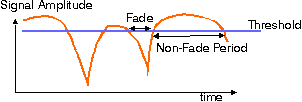 |
Sample of a "fading" signal envelope: amplitude
in dB versus time or location of the antenna.
Wave interference of multiple reflected waves, each with a different amplitude
and phase, causes fluctuations of the received signal amplitude. Changing
the antenna location or the carrier
frequency also changes the signal amplitude.
|
|
Channel impairments, such as fading
and multipath dispersion
can be characterized by the Doppler
spread, the time
constants of fading, fade duration,
level
crossing rates, (Rayleigh
, Rician
and Nakagami)
amplitude probability
densities and the coherence
bandwidth. Scatter plots summarize the
most relevant aspects of channel behavior. The radio propagation characteristics
depend on the environment, so the parameters essentially differ for outdoor
micro and macro cellular systems, indoor
systems, short-range vehicle
to vehicle systems.
The developments in digital microelectronics and signal processing provided
methods to overcome the anomalies of the mobile channel, thereby accelerating
the growth of wireless communication. One of the fundamental concepts to tackle
the channel problems, is diversity
reception, which can substantially improve the link performance. While traditionally
techniques such as maximum
ratio combining have been developed to optimally receive signal in the presence
of Gaussian noise only, current systems exploit adaptive
antennas to cancel interference. Moreover advanced digital modulation methods,
such as spread
spectrum or MultiCarrier Modulation (MCM)
appear suitable for wireless communication. Orthogonal Frequency Division Multiplexing
(OFDM),
a special form of MCM,
will be used extensively in digital terrestrial broadcast systems, e.g. in DAB
and DTTB.
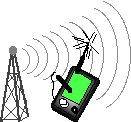
Meanwhile, many new developments in wireless
office networks (e.g. based on HIPERLAN
or IEEE 802.11) involve spread-spectrum
transmission, and allow coexistence with other services. IEEE
802.11, Bluetooth and many
proprietary solutions use deregulated (ISM)
radio bands. Spreading methods include slow and fast frequency
hopping, time hopping, direct
sequence CDMA and multi-carrier
CDMA. Spread spectrum signals appear relatively robust to multipath dispersion
and can furthermore allow multiple users to share the same radio band. The rake
receiver has been developed to optimally exploit the wideband character of the
direct-sequence signal transmitted over a frequency-selective channel.
Managing Scarce Spectrum Resources
State-of-the-art signal processing can resolve most of the problems associated with the
physical transmission over the unreliable wireless channel. So, nowadays the main issues
are the complexity of communication protocols that support full user mobility, (including mobility across cells, networks or even across operators), the power consumption in the mobile or portable terminal, and
the spectrum scarcity.
Due to spectrum scarcity, methods to efficiently share bandwidth among multiple users appeared of utmost
importance. This implies the combined use of
Cellular Frequency Reuse
| |

|
Figure: Theoretical
frequency reuse plan for cellular telephone network. The coverage area
is split into may cells, each using its own radio channel. Channels
can be reused in cells that are separated far enough from each other
to avoid mutual interference of their radio signals. |
|
In the planning of cellular networks, operators employ computer methods
to estimate the coverage and outage
probability. Capacity enhancements are obtained through cell sectorization,
reuse partitioning, dynamic
channel allocation and statistical voice multiplexing (DSI,
which is used for instance in PRMA).
Relevant performance criteria are subjective
voice quality (signal outages and speech clipping), call blocking
probability and lost call rates.
Multiple Access
 In future wireless multimedia networks or
communication networks for Intelligent Transport Systems , the multiple access
issue becomes substantially more important than it is for circuit-switched voice
communication. The ALOHA , CSMA
and ISMA
protocols all allow multiple users to share radio communication resources. How these
protocols perform differs substantially for guided (wired) and unguided (radio) channels;
performance highly depends on the physical propagation characteristics of the channel.
In future wireless multimedia networks or
communication networks for Intelligent Transport Systems , the multiple access
issue becomes substantially more important than it is for circuit-switched voice
communication. The ALOHA , CSMA
and ISMA
protocols all allow multiple users to share radio communication resources. How these
protocols perform differs substantially for guided (wired) and unguided (radio) channels;
performance highly depends on the physical propagation characteristics of the channel.
To attempt a realistic analysis of the
performance of wireless radio networks, two common assumptions for wireline networks must
be refined:
- a data packet is always received successfully if no conflicting transmission (collision)
occurs simultaneously on the same channel
- data packets involved in a collision are always lost.
In wireless networks, fading, inter and intra cell interference and capture effects are present and significantly affect
performance, such as the throughput, stability and delay for a wireless ALOHA-net.
Moreover, the performance seen by each participating terminal differs from the network
average performance and highly depends on
the terminal's location. The and delay depend on channel characteristics.
Specific solutions exist to efficiently resolve message collisions: these include the
tree algorithm, the stack algorithm and dynamic frame length ALOHA. The combined use of CDMA and random access leads to interesting new system
concepts.
|
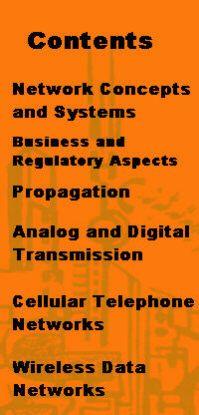
|
 Hundreds of html pages cover many aspects of wireless communications.
The contents are distributed over several main chapters, which are summarized
on the left. A full table
of contents is available. For instance, wireless
systems and standards are covered, such as GSM,
DECT,
AMPS,
Cellular
CDMA, Iridium,
wireless
LANs, Digital Audio
and Video
Broadcasting. It also provides a brief historical
setting as well a discussion of the potential of various system concepts.
The journal gives you an in-depth discussion of the technical issues,
concepts and solutions behind these system standards. This includes the
fundamentals of the radio
propagation channel, digital
and analog
transmission, multiple
access schemes, random
access schemes, cellular
reuse, etc. Bibliographic references
on many topics are given.
Hundreds of html pages cover many aspects of wireless communications.
The contents are distributed over several main chapters, which are summarized
on the left. A full table
of contents is available. For instance, wireless
systems and standards are covered, such as GSM,
DECT,
AMPS,
Cellular
CDMA, Iridium,
wireless
LANs, Digital Audio
and Video
Broadcasting. It also provides a brief historical
setting as well a discussion of the potential of various system concepts.
The journal gives you an in-depth discussion of the technical issues,
concepts and solutions behind these system standards. This includes the
fundamentals of the radio
propagation channel, digital
and analog
transmission, multiple
access schemes, random
access schemes, cellular
reuse, etc. Bibliographic references
on many topics are given.
Educational tools help you to set up
a "A First Course" giving you an introduction to wireless communication.
The glossary helps you to rapidly
understand and acquire the buzz words of this field. A video
presentation on the basics of wireless systems was produced by the
Berkeley Multimedia Research Center. Playlists
provide a selection of audio clips, talks and interviews. A narrated sampler
demo or a word of welcome and a selection of audio
fragments from interviews featured.
To test your knowledge, check our wireless communication quizzes
or the radio link design exercise. |
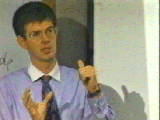
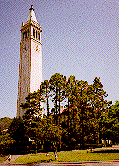 The material
presented on the first edition in 1996 mainly contained material from a graduate
course. In 1994 and 1995 this course was offered by the U.C. Berkeley Continuing
Education in Engineering, University Extension program. In the second edition
released in 1997, about 20 other
authors extended and elaborated this material. The third edition (1999)
shows a continuation of this trend. Contributions from some 35 authors include
more than 1200 html pages, The quizzes and
design exercises have been introduced and tested
during a company training for engineers and designers.
The material
presented on the first edition in 1996 mainly contained material from a graduate
course. In 1994 and 1995 this course was offered by the U.C. Berkeley Continuing
Education in Engineering, University Extension program. In the second edition
released in 1997, about 20 other
authors extended and elaborated this material. The third edition (1999)
shows a continuation of this trend. Contributions from some 35 authors include
more than 1200 html pages, The quizzes and
design exercises have been introduced and tested
during a company training for engineers and designers.
We attempt to maintain a high degree of
consistency in our mathematical notation and definitions throughout the site.
Please be aware of our list of symbols.
Getting Started and Navigational Aids
You need a World Wide Web browser to access the material, but an on-line Internet
connection is not necessary. To fully enjoy this material, your browser should
be able to access audio, view acrobat text and
show video. See: further
instructions, setup and testing.
This journal is written in hypertext which facilities easy browsing. There is not an
intended sequential order of going through the material. However, the table
of contents may suggest a way of sequentially scanning the contents. On every page,
the chapter and section are mentioned. Moreover, at the end of each page, you'll find the
following suggestions for further browsing:
|

|
By clicking on this icon, you return to the table of contents
|
|
|

|
A click on this icon returns you to a page with a more basic discussion of the topic.
|
|

|
This icon suggests a next page, usually with a continuation of the discussion of the
topic. |
Wireless Communication Reference Website
© Jean-Paul M.G. Linnartz
(Editor-in-Chief), 1996-2010.





 In future
In future 

 The material
presented on the first edition in 1996 mainly contained material from a graduate
course. In 1994 and 1995 this course was offered by the U.C. Berkeley Continuing
Education in Engineering, University Extension program. In the second edition
released in 1997, about 20
The material
presented on the first edition in 1996 mainly contained material from a graduate
course. In 1994 and 1995 this course was offered by the U.C. Berkeley Continuing
Education in Engineering, University Extension program. In the second edition
released in 1997, about 20 
